 |
Somerset &
Dorset Joint Railway Winsor Hill and Downside Siding |
 |
||||||||
|
||||||||||
The signal-box and sidings at Winsor Hill were situated on the main line of the Somerset & Dorset Joint Railway (S&DJR), on the section from Bath Junction to Evercreech Junction in the county of Somerset which was known historically as the 'Bath Extension'. The Somerset and Dorset Railway (S&DR) opened its 'Bath Extension' from Evercreech Junction to Bath in 1874 and at first the line was single-track throughout with just a few passing-places, but the line through Winsor Hill was doubled in 1892. [Click here to read more about early S&DR/S&DJR Signalling and the Bath Extension]. The S&DR became the S&DJR in 1875 when the line was leased jointly by the Midland Railway (MR) and London & South Western Railway (L&SWR).
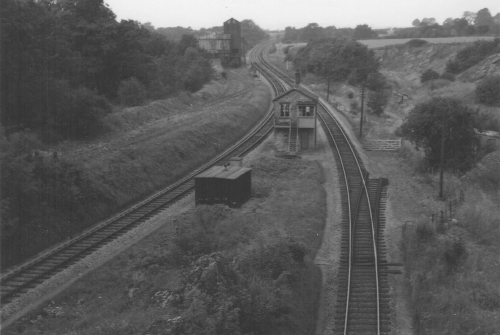
Winsor Hill looking north circa-1953
After the Grouping of the railways of Great Britain in 1923 the S&DJR became a Joint line under the control of the London, Midland & Scottish Railway (LMS) and the Southern Railway (SR), who were the successors to the MR and L&SWR respectively. When the railways were nationalised in 1948 the Joint line came under the control of British Railways (Southern Region) (BR(SR)), but in due course control of the old Bath Extension section passed to British Railways (Western Region) (BR(WR)) until the line closed on 6-March-1966, by which time Winsor Hill itself had been closed for at least 15 years.
Winsor Hill is something of a 'mystery location' for historical research. Remote from any station, it received relatively little attention from railway enthusiasts and sadly most photographs of the location date from after closure of the signal-box and sidings. There appear not to be many surviving offical records of any changes which may have taken place there, and even the details of its run-down and closure are rather confusing. It is hoped that these notes will throw some light on the situation, but further information is always welcome.
Note: the alternative spellings 'Winsor' and 'Windsor' have both been used in various maps for different features in the area. The 'Winsor' variant appears to have been adopted by the S&DJR circa-1900 and is used in RailWest. Similarly, although the name of the quarry at Ham Wood was written usually as two words, the S&DJR generally used the single word 'Hamwood' to describe the railway features.
When the Bath Extension was opened in 1874 the line was single-track throughout, with just a few passing-places. About 1½ miles south of the station at Masbury the line crossed over Hamwood Viaduct and then passed through a single-bore tunnel under Winsor Hill, but initially there was no other railway installation at that location. However in 1876 a siding "for Mr Beauchamp" was opened there to serve the adjacent Winsor Hill Quarry. The quarry and the siding were located on the Down side of the line immediately north of the tunnel, with the access point for the siding facing to Up trains. A new signal-box was opened to control the siding and this was an elevated wooden structure situated on the Up side of the line next to the siding point. Details of the signalling are incomplete, but apart from the siding point and its Facing Point Lock there were Distant and Home signals in both directions, the two Up signals being south of the tunnel.
Although some sources quote 1875 for that work, according to National Archives file MT6/156/11 the S&DJR advised the Board of Trade (BoT) that they wished to bring the siding into use on 1-May-1876. Clearly it was inspected about that time, as a letter from Colonel Yolland dated 5-May-1876 required the provision of electric repeaters for the Distant signals as they could not be seen from the signal-box. He also stipulated that the signal-box had to be a block-post, but later in the same year the S&DJR decided that it would cease to be a block-post (Minute 369 of S&DJR Officers' Meeting on 8-November-1876), and it is believed that change took effect on 1-January-1877 (a date recorded by the late CR Clinker from S&DJR Signal Instruction No 3). There is more information about the early block working below.
In 1892 the line from Binegar to Shepton Mallet was doubled and that work included the provision of a new signal-box (SB) at Winsor Hill (and also a new SB at Masbury). The existing single-track tunnel was retained for use for the Down line, whilst a new single-track tunnel was bored alongside it to take the new Up line. Whilst the old tunnel was 242 yards long the new tunnel was only 132 yards in length, as it was built a short distance to the west of the old tunnel through a narrower part of the hill. As a result the gap between the two lines was wider than normal at the approaches to the two tunnels and so the new SB was built between the two lines a short distance north of the tunnels.
The new SB had a superstructure entirely of stone, so it was unique on the S&DJR in terms of both its construction and location between the running lines. (It is a matter of speculation whether the lack of a timber superstructure reflected the local availability of suitable building stone or a desire to provide a level of protection against accidental damage from any blasting in the adjacent quarry.) The SB was equipped with a 16-lever frame (of the Stevens pattern with levers at 4.1/8" centres) which was installed facing the Up line, although the building had windows at both front and back in order to give the signalman a good view of both lines. When the SB was opened only 8 of the 16 levers were in use, but it would seem clear that provision had been made for later expansion. (Three of the working levers were push-pull levers, which stood normally in a mid-way position; pulling a lever back worked one signal, pushing the lever forward worked a different signal.) A crossover was provided between the Up and Down lines and of course the connection to Winsor Hill quarry remained in use in the Down line. There were Distant and Home signals on both lines and ground signals for shunting moves over the two sets of pointwork. The new SB became a block-post for the new double-track sections to Masbury and Shepton Mallet (more information about the later block working below).
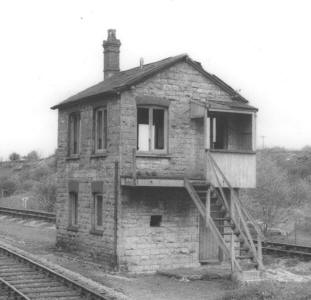 |
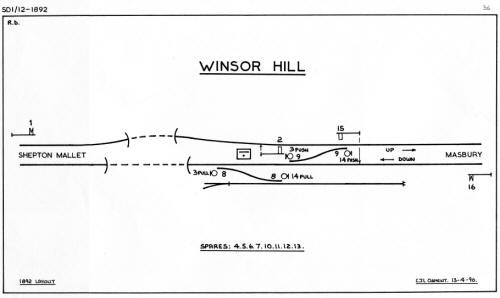 |
|
| Winsor Hill second signal-box
(after closure) Click picture for larger image |
Winsor Hill Signal Diagram 1892 Click diagram for larger image |
The doubling work was inspected for the BoT by Major Marindin on 15-November-1892 (National Archives file MT6/614/2) and his Report stated that actual double-line working was not in use at that time as the new connections had not been made yet at Binegar and Shepton Mallet. A later file entry dated 30-January-1893 states that "due to hard weather" at least another two weeks would be required and a further inspection was not made until 14-March-1893, by which time double-line working was in operation. Some sources state that the signal-box was opened on 2-November-1892 and the double-line brought into use on 20th November; the late CR Clinker recorded that S&DJR Signal Instruction No 56 gave the latter date for opening of the double-line and the 21st November for the opening of the signal-box itself, but no copy of that Instruction has been sighted yet for confirmation.
It was not long before there was an expansion of the facilities at Winsor Hill. In 1893 a siding "for Mr Somerville" was opened to serve the nearby Ham Wood Quarry and this was situated on the Up side of the line, with a trailing connection some distance north of the crossover leading to two parallel sidings. Two of the spare levers (10 & 11) were brought into use, one for the points and the other as a push-pull lever to control new ground signals for movements into or out of the siding. The work was inspected on 1-June-1893 (MT6/619/13) and it is believed to have been brought into use on the same day (Clinker records that date from Signal Instruction 60). The sidings served the quarry's stone-crushing plant, which was connected by a tramway incline to the actual quarry a short distance away down in the valley. By contrast, the connection off the Down line led to a number of sidings within Winsor Hill Quarry itself, which was immediately adjacent to the S&DJR main line.
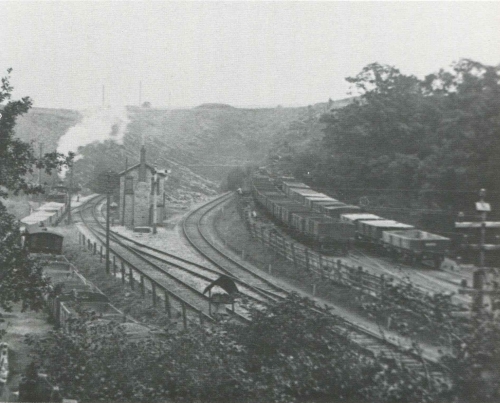
Winsor Hill looking south circa-1900
In 1900 a siding "for Messrs Wainwright & Co" was opened to serve Downside Quarry, which was a short distance south of Winsor Hill tunnels on the Down side of the line (Clinker recorded the opening date as 25-October-1900 according to Signal Instruction 132). The new siding had a trailing connection into the Down line and was worked by a new Downside Siding ground-frame (GF). This GF was housed in a pent-roof wooden hut (typical of contemporary L&SWR GF huts) and had a 5-lever frame, probably of the Stevens 'knee' type used at other S&DJR GFs. As the GF was located in the block section between Winsor Hill and Shepton Mallet, then any train shunting at the GF was protected by the Down Home (15) at Winsor Hill, which controlled entry into that block section. However, in accordance with contemporary practice, the GF was provided with its own Home and Distant signals (on the Down line only), which normally stood in the 'off' position when the GF was closed. In order to shunt the siding the Guard or Shunter, having unlocked the GF, had first to restore Home and Distant levers (4 and 5) to normal before he could operate the points. Conversely, when work had been completed then 4 and 5 were pulled 'off' again before the GF was closed.
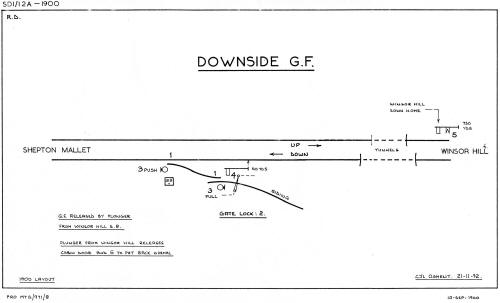 |
![Downside Siding GF hut [Norman Lockett Archive © David Lockett]](../../images/gf/~downside.jpg) | |
| Downside Siding GF Diagram 1900 Click diagram for larger image |
Downside Siding GF Hut 1938 Click picture for larger image |
The GF was locked by a Sykes 'Lift-to-Plunge' instrument located in a box on the outside of the GF and released by a similar instrument in Winsor Hill SB (click here for more information on these instruments). Any train wishing to shunt the siding would be signalled into the block section to Shepton Mallet as a "Ballast Train stopping in section". Once the train had passed the Down Home at Winsor Hill then lever 15 would be replaced, and subsequently it would become locked normal once the signalman had operated his Sykes instrument to release the GF. When work at the siding had been completed and the GF re-locked, then the Sykes instrument would be released and lever 15 would be 'free' again. The train would then continue on to Shepton Mallet.
The operating instructions for Downside Siding contained in the 1905 edition of the S&DJR Appendix to the Working Timetable (WTT) can be read here and those from the 1914 edition here. It is interesting to note that in 1905 the keys for the GF were held at Winsor Hill signal-box, whereas by 1914 they were kept at Shepton Mallet; it is possible that this change reflects a trend towards working the traffic solely to/from the latter place. The later instructions in the 1933 WTT Appendix dealt more with the handling of the trains than the actual operation of the GF, for which it simply refers to 'instructions exhibited at the ground frame'.
[Note: some sources state that Downside Siding GF was released by a key from Winsor Hill SB, but it is considered that this is probably a mis-interpretation of the need for the GF operator to obtain keys for the locks on the bell box and hut door at Downside Siding; those keys did not unlock the actual GF lever-frame. Details of the Sykes instrument release are taken from official S&DJR records and accord with contemporary practice for such locations.]
With the opening of Downside Siding GF the signalling at Winsor Hill probably reached its fullest extent, as shown on the 1900 signal-box diagram below. This diagram shows the arrangements for the 1893 Hamwood sidings on the Up side, and the new Down Distant for Downside Siding GF located below the Down Home (15). There is a suspicion that the Down Home was now further away from the SB than when originally installed in 1892, in which case it was probably relocated in 1893 to permit the installation of the Up siding - certainly it was in the position shown in the diagram before the lower distant arm was added in 1900. By the mid-1920s at least the Down Home was on a very tall post, probably to provide better sighting for Down trains approaching from Hamwood viaduct, hence the signal also being on the right-hand side of the line.
One item not marked on the diagram was a spring-loaded trailing catch-point located on the Up line some distance in rear of the Up Home signal. This catch-point would have been provided to guard against any runaways, whether from Up goods trains or shunting operations at Winsor Hill, running 'wrong direction' back along the Up line on the steep gradient down towards Shepton Mallet. It is not known if it was installed in 1892, or perhaps 1893, but certainly it was listed in the 1905 S&DJR WTT Appendix which stated that "the position is indicated by the word 'Switch' painted in black letters on the small Signal-box covering the handle of the Catch Points". (That 'signal-box' would have been little more than a small hut.) The precise original location of the catch-point is unknown, but by the time of the 1933 SDJR WTT Appendix it had been moved out to 540 yards in rear of the Up Home (which would place it roughly opposite the site of Downside Siding) in order to provide clearance for the longer goods trains that became possible after the introduction of the 2-8-0 '7F' engines (see Minute 7786 of the S&D Officers' Conference on 23-April-1926). At some unknown date the 'box' was removed and replaced by a small 'CATCH POINTS' notice on a post close to the catch-point lever.
On 4-January-1939 the Up Distant signal was replaced by a new signal 12' high erected close by, and then on the following day the Down Distant was replaced by a new signal, also 12' high, in a new location 294 yards further from the SB and 1,100 yards away from the Down Home. Both changes were covered by Signal Instruction 375. The revised situation can be seen in a signal diagram for 1939.
Given the generous provison of spare levers, it is a little surprising that no Starting signals were provided at Winsor Hill, with the result that all shunting movements on the main lines would have required the occupation of the block sections to Masbury and/or Shepton Mallet as relevant. Admittedly the provision of a Down Starting signal might have been complicated by the proximity of the entrance to the Down line tunnel, but it would seem to have been a much easier task to install an Up Starting signal.
A temporary signalling alteration took place in 1946, although not directly related to Winsor Hill itself. Following the partial collapse of Bath Road viaduct on the northern outskirts of Shepton Mallet, a temporary signal-box named Waterloo Road was erected there while the repair work was in progress. This SB became a block-post between Winsor Hill and Shepton Mallet and its Down Distant signal was installed as a lower arm (fixed at caution) below Winsor Hill's Down Home (just like the previous Down Distant for Downside Siding GF). Although the initial work to repair the viaduct was completed later in that year it would appear that the facilities were used again for further repair work in 1947, but probably all the temporary signalling would have been removed by the end of 1947 at the latest.
When the Bath Extension was opened in 1874 the block working was 'Absolute Block' using just block telegraph instruments without any train staff. The new siding provided for Winsor Hill Quarry in 1876 was located within the original single-line section between the passing-loops at Binegar and Shepton Mallet (although it appears that Masbury was already an unofficial block-post by that time) and so it needed to be protected by local signals worked by its own signal-box. The new SB was made a block-post at the specific request of Colonel Yolland (National Archives file MT6/156/11). However the possible problems at such a location without a passing-loop soon became horribly apparent with the disaster at Foxcote (near Radstock) in August 1876 and that was probably a factor in the subsequent decision by the S&DJR that Winsor Hill would cease to be a block-post (Minute 369 of S&DJR Officers' Meeting on 8-November-1876), which is believed to have taken effect on 1-January-1877 (Signal Instruction 3). However it is clear from the instructions in the S&DJR WTT Appendix No 7 (1-March-1886) for working the siding that the former SB was still manned at that time, the same Appendix also listing the opening hours as 5:30am-5:30pm weekdays only (ie not Sundays).
Subsequently on 10-October-1886 Electric Train Tablet (ETT) working was introduced on the single-line section between Binegar and Shepton Mallet (using Tyers No 1 instruments). In later years it became the practice to dispense with signals at intermediate sidings on single-lines and have the siding GF locked/unlocked by a tablet for the block section, but it is clear from the instructions for Winsor Hill in the WTT Appendix No 8 of 1-October-1886 (click here) and the WTT Appendix No 9 of 1-February-1889 (click here) that the former SB remained as a manned location. It is possible that this was a precautionary arrangement so that the signalman could use his Distant and Home signals to protect the line in any emergency arising from blasting in the quarries. The opening hours remained as 5:30am-5:30pm weekdays only.
When the the line was doubled in 1892 and the second SB was opened, then Winsor Hill became a block-post again. The block working reverted to Absolute Block and is presumed to have used the S&DJR standard 'block telegraph' instruments for the new double-track sections to Masbury and Shepton Mallet. By the time of the 1905 edition of the S&DJR WTT Appendix the opening hours for the SB were listed as 7:00am-5:30pm (weekdays only), but by 1914 this had been changed to 9:45am-5:45pm (weekdays only).
A small change occurred in 1927 with the introduction on 10th October of a Bank Engine Staff on the Down line between Binegar and Masbury. Although this change did not affect the actual method of block working at Winsor Hill, the S&DJR block telegraph instrument for the section to Masbury was replaced by a SR standard 3-wire 3-position instrument in order to provide the necessary block controls whenever Masbury was 'switched out' (the S&DJR instrument working to Shepton Mallet was not changed).
As there was no passenger station or public goods facilities at Winsor Hill then clearly, apart from controlling the normal rail traffic passing by on the main line, the main function of the signal-box was to manage the stone trains which shunted the various quarry sidings. Instructions about working the 'stone sidings' were provided in the S&DJR WTT Appendix and details are known for the March 1886, October 1886, February 1889, 1905, 1914 and 1933 editions.
The instructions indicate that traffic was handled both by scheduled through trains and also by 'trip workings' from Shepton Mallet. It is clear also that, prior to the doubling of the line, engines were allowed to propel wagons from Shepton Mallet to Winsor Hill. It would appear that a lot of the empty wagon traffic was worked up the line from Shepton Mallet, which necessitated running-round the train at Winsor Hill if the wagons were destined for the siding on the Down line (described variously as 'Beauchamp's siding' or 'Mendip siding') or for Downside Siding. Because there was only one crossover at Winsor Hill the engine had to leave its train on the Up line there and proceed to Masbury in order to cross over and return to Winsor Hill on the Down line. One can only assume that any inconvenience caused by such working was deemed to be outweighed by the cost of providing a second crossover and additional signalling to enable the run-round to take place at Winsor Hill.
Separate instructions dealt with Downside Siding and copies are available from the 1905, 1914 and 1933 editions of the S&DJR WTT Appendix. The two earlier editions contained instructions for the actual operation of the GF as well as the working arrangements for the trains, but the 1933 edition concentrates on the latter and for working the GF simply refers to 'instructions exhibited at the ground frame'. A particular feature of trains for Downside Siding seems to have been the facility to convey wagons from Shepton Mallet by putting them between a bank engine and the rear of a single-load Up goods train (ie a train which would not otherwise need a bank engine). The train would stop at Winsor Hill clear of the crossover, the shunter would uncouple the wagons from the brake van at the rear of the main train which would then proceed on its way, leaving the bank engine to draw its wagons across to the Down line ready to proceed to Downside Siding. (It is not known why this method was described specifically for traffic for Downside Siding and not also for 'Beauchamp's siding'.) The use of the special 'Downside Siding Disc' mentioned in the instructions is intriguing, as once the bank engine and wagons were on the Down line there would seem to have been no difference between that train and a normal Down train shunting at Downside Siding. It is not clear whether the 'disc' was used instead of, or in addition to, a tail-lamp on the last wagon, or on the engine when returning to Shepton Mallet.
It has been recorded (but not verified) that regular manning of Winsor Hill SB ceased with effect from 16-October-1938 and thereafter the SB was 'open as required', being worked by the signalman from Masbury who would walk down the line to Winsor Hill. This arrangement was probably a reflection of a decline in traffic needs. A visitor to Winsor Hill in that year reported that Hamwood sidings were closed and appeared to have been out of use for about 8-10 years by that time. (Apparently there were still a few loaded wagons in the sidings covered in moss and rusting away!) Downside Siding GF was closed on 23-January-1940 (S&DJR Signal Instruction 382) and its points and signals were abolished, so the lower distant arm beneath Winsor Hill's Down Home would have been removed at that time, although it is not known when the siding points were actually removed from the Down line. (It has been reported, but not verified, that Hamwood sidings were closed in the same month.) In the late 1940s a member of the staff at Shepton Mallet used to walk to Winsor Hill once a week in order to tend the signal lamps there and he reported that the SB was still manned as required from Masbury. There is no known information about any possible increase in the manning of Winsor Hill while the temporary Waterloo Road SB was in use in 1946/47.
In 1948 the S&D Fortnightly Notice SR No 16 reported as follows:-
"Winsor Hill Siding: Commencing at 9:00am on Thursday August 5th until completed same day, the Down Distant, Up Distant, and Up Home signals, applicable to the above siding, will be put out of service, the arms, lamps, spectacles, being removed from the posts."
It was a common practice of the former SR to remove the arms and lamps from signals at locations where the signal-box was likely to be out of use for an extended period in order to reduce maintenance costs - in effect the installation was 'mothballed' with the signal-box 'switched-out'. It would appear therefore from that Notice that the stone traffic from Winsor Hill quarry had ceased by that time.
A BR(SR) copy of the signal-box diagram circa-1950 shows a layout essentially the same as in 1939, but with the main running signals drawn simply as posts with no arms on them. All the ground signals are still shown as complete. Levers 1 and 16 are marked as being fixed in the reverse position - as the interlocking required levers 2 and 15 to have been reversed as well, thereby locking points 8, 9 and 10, then effectively the layout was secured against unauthorised use. (It is not known whether the points were also clipped and padlocked at that time as an additional precaution.) However it is most peculiar that Notice 16 made no mention of the Down Home, even the post for that signal is not shown on the BR(SR) diagram, and the description for that signal has been removed from the locking-table (although the actual locking remained). So it would appear that, for some inexplicable reason, the Down Home had simply vanished from the layout!
Then in 1951 a S&D Notice was issued as follows:-
"Winsor Hill Signal Box:
Further to S&D Fortnightly Notice SR No 16 1948, when certain signals at the
above Box were taken out of service:
To be carried out on
Wednesday 10th October, commencing at 8:00am:
Winsor Hill Signal
Box will be abolished and all signals and points worked therefrom will be
put out of use, the latter being clipped and padlocked in the normal
position. The block section will then be between Masbury and Shepton Mallet
(Charlton Road)."
Most publications relating to the S&DJR have quoted 1948 for the closure of the signal-box at Winsor Hill, but it is clear from the texts of the relevant Notices that in fact the formal closure did not take place until 10-October-1951. It is probable that there had been a misunderstanding of the 1948 Notice 16 by one historian, which regrettably then had been repeated elsewhere by other writers, and of course the 'mothballed' state of the installation during the 1949-51 period would have added to the illusion of closure.
Although the signal-box was stripped of its contents some time after closure, the derelict superstructure remained in place throughout the BR era and was not demolished until after the closure of the railway in 1966. The crossover road (points 9) was removed during the period 13/19-December-1952. By 1954 the sidings into the Winsor Hill quarry appear to have been lifted, but the actual trailing point (No 8) in the main line remained in place for some years until the Down line was relaid (at an unknown date). Despite having been out of use for many years previously, the Hamwood sidings somehow survived virtually intact, although the boundary fence had been extended across the actual entrance trackwork. Although slowly disappearing under the encroaching vegetation, the sidings and even the trailing point (10) in the Up line were still in place when the line closed in 1966. The catch-point in the Up line south of the tunnel remained in use until the S&DJR itself was closed.
The S&DJR closed to all traffic on 6-March-1966, except for four short sections which survived for goods traffic for a few years more. The main line through Winsor Hill was lifted in early 1968, along with the derelict Hamwood sidings, and since then the trackbed has became an informal footpath through the tunnels. The former Down line 'old' tunnel was used for a short while by Rolls-Royce Ltd as a site for destructive testing of their 'Olympus' engine intended for the Concorde aircraft, so steel doors were fitted at each end in 1968, but removed eventually in 1990. Apart from the tunnels themselves, little trace now remains of the S&JDR at Winsor Hill other than Hamwood viaduct, almost hidden away in a wooded valley.
© CJL Osment 2015-23
Thanks to Steve Ehrlicher and Peter Kay for material from the National Archives, to Mike Arlett for additional archive
material, and Peter Russell.
Downside Siding GF photograph from
Norman Lockett Archive © David Lockett, Winsor Hill photographs courtesy
Keith Barrett collection.
References